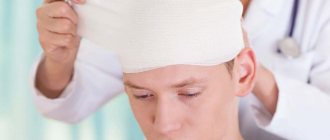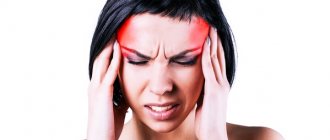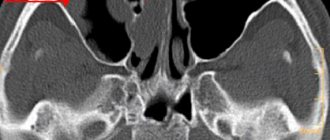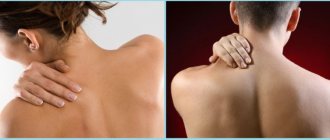Causes
The exact cause of migraine in a particular person can be difficult to determine. The most common predisposing factors include the following:
- increased intracranial pressure,
- osteochondrosis,
- stress,
- overstrain of the muscles of the shoulder girdle and head,
- heredity,
- following strict diets with strict restrictions,
- insufficient intake of water into the body.
Previously, doctors believed that migraines were a consequence of dilation of blood vessels in the brain, but this theory is now recognized as erroneous. The attack is caused by a number of biochemical processes that are triggered by neurons located in the cerebral cortex. Neurons, for various reasons that are not yet precisely known to specialists, begin to activate. This automatically releases inflammatory substances near the blood vessels. The final stage is inflammation of the vessel itself and the surrounding tissue, which manifests itself as a headache.
Migraines often affect members of the same family. More than 80% of patients inherit the disease from their parents. However, changes in the genetic makeup that would be responsible for this pathology have not yet been found.
Up to contents
Causes of migraine
Causes of migraine in the brain and disorders in it. There are several theories for the development of this type of headache:
- Spasm of blood vessels in the head and short-term cerebral circulatory disorders.
- Changes in the bioelectrical activity of different areas of the brain.
- Trigeminal nerve irritation.
- Imbalance of neurotransmitters in the nervous system.
- Increased excitability of neurons - nerve cells of the brain.
Each of these factors contributes to the triggering of pain and associated symptoms. Increased excitability of neurons, structural features of blood vessels may be congenital features, and migraine has a family history in the patient.
The development of a migraine attack is provoked by various factors:
- Changes in hormonal levels in different phases of the menstrual cycle or when taking hormonal contraceptives.
- Strong feelings, fear.
- Fatigue and lack of sleep.
- Intense work that requires concentration.
- Staying in a stuffy or hot room for a long time.
- Changes in climate or weather.
- Strict diets, fasting, a number of foods: chocolate, red wine, cheeses, smoked meats.
- Smells of tobacco smoke or others.
- Taking certain medications.
- Flickering light or prolonged exposure to bright sun.
Everyone has their own list of triggers. Keeping a diary will help you identify patterns - after which your head starts to hurt. It needs to note your diet, emotional state and other points.
Quite often there is a correlation between migraines and fluctuations in the level of the female sex hormone estrogen. Hence the first appearance of unilateral headaches during puberty, severe attacks during menstruation, and an increase in their frequency after the birth of a child and with the onset of menopause. During this time, estrogen levels decrease, which may be associated with migraines.
In addition, scientists talk about familial migraine, a rare type of disease that is associated with gene defects in chromosomes. Research into the genetic cause of the disease is still ongoing.
Types of migraine
An attack of pain can be either severe, when a person is unable to engage in usual household activities, or not so pronounced.
By manifestations
- With an aura. An aura is a specific condition that precedes a headache. Patients report a number of symptoms:
- visual – sparkling lines in the form of zigzags or fog before the eyes. Bright flashes are followed by dropouts in visual fields (blind spots). Objects may appear larger or smaller than their actual size, or their color may also appear different;
- sensory – tingling and numbness in the body, sensation of crawling on the skin;
- motor – difficulty coordinating movements, muscle weakness, hemiparesis;
- speech disorders - hesitation, stretching of words.
Dizziness, weakness, and a feeling of unreality of what is happening are also common. Each symptom can last from 5 minutes to an hour. After completing this phase, at least one of the listed manifestations goes away.
- No aura. More than half of migraine cases resolve without an aura. This course is called simple, since the attack passes much easier. However, patients still suffer from excruciating throbbing pain, nausea and sensitivity to light and sound.
By frequency of attacks
In this case, migraine may be:
- episodic. Occurs rarely and passes without obvious symptoms;
- chronic. We are talking about the chronicity of the process if the attacks occur for more than 15 days within one month, and this is observed for 3 months or more.
There are also other types of migraines:
- flickering. It is characterized by a visual scotoma - light glare or zigzags. The attack is rarely accompanied by a headache, limited only to visual discomfort;
- basilar. It often begins in adolescence and is predominantly found in girls. Sometimes it is called migraine epilepsy, since changes specific to epilepsy are noted on the EEG (electroencephalogram) during an attack;
- cervical In addition to all the standard symptoms, the involvement of the neck muscles in the process is added. The pain spreads to the lower back of the head, temples and eye sockets;
- abdominal. Usually characteristic of children and manifested by abdominal pain in the form of attacks. They can last up to 3 days, or they can end in an hour. No other symptoms characteristic of gastrointestinal pathology are observed. Between attacks of pain, the child feels well and behaves as usual.
A doctor must deal with each case and identify migraine, distinguishing it from many similar diseases. According to statistics, only half of people suffering from headaches turn to specialists. However, such an attitude towards one’s health can lead to the progression of the disease.
Up to contents
Symptoms of migraine with aura
The main symptom is considered to be visual impairment, which is why experts sometimes mistake this migraine for optic neuritis. Patients see illusory zigzags, flickering and moving highlights, and color spots. Along with this, it is often difficult for them to navigate in space and focus their gaze on objects, which during attacks always seem lower than usual and are covered with black and white spots.
Migraine of this type is characterized by both visual and auditory hallucinations: extraneous noises and voices of varying degrees of volume.
Dysphalgia, a state of inability to remember words, put them into sentences and pronounce them, is also common. Another symptom is the appearance of a tingling sensation in the fingertips. The tingling may move higher up the arm and even spread to one cheek, temple and affect the tongue.
It happens that the aura makes itself felt with symptoms such as nausea and vomiting, dizziness, general deterioration of the condition, drowsiness, and involuntary twitching of the limbs.
The listed signs appear 10-60 minutes before the headache. An attack can last from 2-3 hours to several days in a row. A longer duration of the attack indicates migraine status. Patients complain of pain on one side of the head and only in rare cases on both sides. The headache is preceded by pulsation in the area of one or two temples, a feeling of pressure on the eyes. Symptoms can be significantly aggravated due to bad habits: smoking, drinking alcohol and drugs.
What can trigger a migraine attack
Often, patients seek to prevent headaches by identifying and eliminating the factors that provoke them. The following conditions can cause migraines:
- eating foods containing tyramine - smoked or dried meat, bananas, chocolate, dried fruits, citrus fruits, hard cheese;
- salt abuse;
- forced or conscious hunger for a significant period of time;
- lack of sleep or too much sleep;
- violation of work and rest schedules;
- excessive consumption of alcohol, tea, coffee;
- too bright lighting and loud sounds;
- flickering light;
- obsessive unpleasant odors (paint thinner, cigarette smoke, perfume, etc.);
- increase or decrease in atmospheric pressure;
- sudden change in weather;
- the arrival of cold weather;
- taking oral contraceptives or estrogen replacement therapy;
- consumption of products containing aspartate or glutamate;
- staying on top.
In pregnant women, migraine attacks become less frequent, which is due to changes in hormonal levels. Often in the second and third trimester the headache goes away completely. However, 4% of women first encounter this disease during the period of expecting a child.
The menstrual cycle also affects the exacerbation of migraines. Some patients suffer from this disease strictly two days before menstruation or three days after. Doctors attribute this to the fact that the level of estradiol in the blood serum drops during the outlined period. With the onset of perimenopause, the situation with migraine worsens, but women in menopause note relief.
Up to contents
Migraine. How does it manifest, factors of occurrence and treatment of the disease
How it manifests itself
Migraine is the second most common headache in the world and the first for which patients seek medical help.
Characteristic features of migraine:
- headache attacks lasting from 4 to 72 hours;
- pain intensity – moderate or severe;
- the nature of the pain is pulsating;
- the occurrence of sensitivity to light, sounds, smells;
- increased sensitivity of the scalp;
- nausea and vomiting;
- increased pain during physical activity (standing up, walking, etc.);
- most often unilateral localization of pain (there are exceptions).
During a migraine attack, the patient temporarily falls out of his usual way of life due to severe headaches that last for several hours or days. The situation can be very serious, leading to maladaptation of a person.
In some cases, migraines are preceded by warning symptoms known as "auras." These include:
- flashes of light or dark spots before the eyes;
- lacrimation;
- a veil before the eyes;
- tingling sensation in the skin of the face, arms or legs (on one side);
- nasal congestion;
- unilateral paralysis of the arms or legs (with hemiplegic migraine);
- speech disorders;
- dizziness.
It has been recorded that one or two days before a migraine a person is accompanied by some changes - increased appetite, bowel movements, neck muscle tension, mood swings, thirst, increased urination, constant yawning, etc.
An aura can occur both before and during a migraine attack. Most people with migraines do not experience any aura symptoms at all. In other patients, the aura most often manifests itself as visual disturbances - flashes of slight wavy or zigzag vision, blurred vision, narrowing of the field of vision.
Sometimes auras manifest as sensory, motor, or verbal disturbances. You may experience muscle weakness or a feeling that someone is touching your body.
All of these symptoms usually begin gradually and tend to increase. The duration of the aura ranges from 5 to 60 minutes.
Here are examples of aura:
- decreased clarity of vision;
- tingling of the limbs on one side;
- muscle weakness;
- numbness of the face or one side of the body;
- speech problems;
- tinnitus, music;
- involuntary jerking or other movements;
- weakness of the limbs (with hemiplegic migraine).
An untreated migraine episode lasts 4-72 hours. The frequency of attacks can be rare, or they can occur up to several times a month. After an attack, a person goes through a post-drome phase. This is the final phase of a migraine, during which some people feel exhausted and tired, while others may feel elated.
During the day following a migraine, you may feel depressed, confused, confused, sensitive to light or sound, or dizzy.
Often the disease is not diagnosed and not treated. If you or someone you love regularly experiences migraine symptoms, keep a record of your pain attacks and how you tried to relieve the symptoms. Be sure to make an appointment with a specialist and discuss any warning signs with your doctor. This will help diagnose the disease and select adequate treatment.
If treatment has been prescribed, but the nature of the headache has changed or the pain has become completely atypical for you, be sure to consult your doctor.
Factors causing migraine
Many patients claim that their migraine attacks depend on certain factors, such as hormonal changes in the body. Some claim that headache attacks increase significantly during pregnancy or menopause.
Let us note the main factors of migraine:
1. Use of hormonal drugs. This includes taking oral contraceptives, hormone therapy during menopause, etc. It should be noted that some women claim that hormonal drugs worsen migraines, while others, on the contrary, note a decrease in the frequency of episodes when taking hormonal drugs.
2. Consumption of certain foods. It has been noted that raw cheeses, highly salted foods and processed foods can trigger a migraine attack. Skipping meals or fasting can also cause a pain attack.
3. Abuse of food additives.
4. Drinking certain drinks. Migraines can be triggered by alcohol (especially wine) and drinks with high caffeine content.
5. Impact of stress.
6. Failure to comply with sleep standards. Migraine occurs when there is a lack of sleep or, conversely, oversleeping.
7. Physical factors. Too intense physical activity (including sexual activity) sometimes leads to illness.
8. Taking medications. An increase in episodes has been noted when taking oral contraceptives and vasodilators (for example, nitroglycerin).
9. Changes in the environment.
10. Changes in atmospheric pressure during flights.
There is a migraine risk group consisting of people most susceptible to episodes of the disease. It includes teenagers, women (migraines are 3 times more common than men), pregnant women and menopausal women. Also, patients whose relatives have ever suffered from manifestations of this disease are prone to migraine.
Migraine treatment
There are two medical tactics for treating the disease - stopping the disease (eliminating an attack) and preventive therapy aimed at reducing the frequency, duration and severity of an attack, as well as improving the quality of life and reducing the likelihood of patient maladjustment. The main components of preventative therapy are: lifestyle modifications, avoidance of triggers, and medications.
Stopping an attack is carried out:
- non-steroidal anti-inflammatory drugs (NSAIDs, NSAIDs);
- triptans;
- paracetamol;
- antiemetics.
Preventive treatment with medications is carried out for four or more severe migraine attacks per month, in the presence of a prolonged aura, symptoms of numbness and weakness, and also if painkillers do not bring the expected effect.
Preparations for the preventive treatment of migraine:
- beta blockers;
- sartans;
- calcium channel blockers;
- antiepileptic drugs;
- botulinum toxin;
- antidepressants;
- non-steroidal anti-inflammatory drugs.
When dealing with migraines, the main thing is not to self-medicate. Only a doctor should make a diagnosis and select the correct treatment. Health to you and your loved ones!
Diagnostics
Migraine is diagnosed solely by symptoms. There are no instrumental methods to confirm it yet. However, to exclude other pathologies that are sometimes hidden under the mask of this disease, MRI and CT examinations may be prescribed. If the resulting images do not reveal any alarming changes, then most likely the patient suffers from migraine.
Up to contents
Treatment
Migraine brings many unpleasant moments to the patient. Treatment for this disease is usually symptomatic. Episodic migraines are treated with abortive therapy, which is designed to stop the attack. Analgesics such as NSAIDs, triptans, and dehydroergotamine have proven themselves to be effective in the fight against migraine. Be sure to take the recommended dose of the drug within the first hour from the onset of the headache. If more time passes, the effectiveness will be much lower.
It is impossible to use medications uncontrollably, otherwise a drug-dependent headache may gradually develop. Only a qualified specialist can take into account all the indications and contraindications for a particular patient. A short-term sleep, immersing the head in warm water, fresh air, bed rest, a darkened room and rest can remove an attack or ease its course.
Up to contents
Migraine treatment
Given the complex nature of the disease, the logical question arises, how to treat it?
If migraine attacks occur rarely and do not greatly affect a person’s performance, it is customary to prescribe medications only at the moment of pain. The first step the doctor recommends is regular NSAIDs (non-steroidal anti-inflammatory drugs), such as ibuprofen, aspirin or paracetamol. If these drugs are not effective enough, you should take triptans - medications designed specifically to combat a migraine attack.
If attacks occur frequently, reduce performance, and respond poorly to treatment, it is advisable to engage in the prevention of migraine attacks. It is carried out not with painkillers, but with drugs that affect vascular tone, the balance of neurotransmitters, and the excitability of neurons - these are beta blockers (drugs traditionally prescribed for hypertensive patients), antidepressants (mainly amitriptyline), anticonvulsants (drugs used to treat epilepsy). This therapy is prescribed for a long period of time and requires daily medication.
Treatment of migraine is a labor-intensive process that requires serious moral and financial resources.
In recent years, many modern techniques have emerged that make it possible to control migraine, effectively prevent the development of attacks and minimize the use of medications. Among these techniques are botulinum therapy, vagal stimulation (X pair of cranial nerves), transcranial magnetic stimulation of the brain.
Features of migraine treatment at the Rassvet clinic
At Dawn, you can consult a neurologist and correctly determine the type of headache. From a wide range of drugs, he will choose exactly the one that, taking into account age, concomitant diseases and capabilities, is right for you. The clinic has the opportunity to undergo botulinum therapy, the most effective method of migraine prevention, on the same day of treatment.
Migraine prevention
For migraines, preventive prescriptions are also made if the patient experiences attacks more than once a month. Taking medications according to the regimen specified by the doctor makes attacks of the disease more rare, their duration becomes shorter, and the manifestations are not so pronounced. As a result, the disease does not become chronic, and the response to abortive therapy becomes better. Antidepressants, beta blockers and some other medications are prescribed for prevention.
Experts advise patients with migraine symptoms to sleep at least 8 hours a day, going to bed at approximately the same time. They should drink up to two liters of water per day and salt their food in moderation. It is advisable to limit the consumption of alcohol and caffeinated drinks or completely avoid them. Patients are often recommended to keep a special diary, where they should write down the following every day before going to bed:
- time of onset and end of the attack, its duration;
- preceding unusual sensations from the eyes or other body systems;
- in what part of the head was the pain felt;
- type of pain (pulsating - intensifying in time with the beat of the heart, squeezing - reminiscent of the sensations of squeezing the head with a hoop, stabbing - similar to sharp pricks with a needle, etc.);
- whether the pain was aggravated by physical activities, such as climbing stairs;
- severity of pain throughout the day (o);
- whether this condition was accompanied by nausea and how severe it was;
- whether there was retching or belching;
- whether there were cases of vomiting during the attack;
- whether the patient was irritated by ordinary daylight, whether he wanted to shade the room;
- did he seek to retire to a quiet place, hiding from the sounds that were familiar to him;
- factors that could presumably influence the occurrence of an attack;
- all drugs with an analgesic effect that were taken during the headache period. You need to indicate the dose and time of administration.
It is necessary to keep a diary for three or more months so that the conclusions from the entries made are reliable. This data helps the doctor evaluate the effectiveness of prescriptions and adjust them in a timely manner. The patient, having analyzed the events preceding the migraine, can consciously change his lifestyle, eliminating the factors that provoke the attack.
Up to contents
Migraine is the main thing
The term itself, translated from Latin, means “pain in half the head.” This is a characteristic sign of the disease - pain that is localized in one part of the head, in the temple area. There are other specific symptoms of migraine:
- Intense pain with a pulsating character.
- Nausea (up to attacks of vomiting), intolerance to light, sounds, smells.
- Aura or precursors are special conditions that appear before a migraine attack: disturbances in the sensitivity of the limbs, vision (appearance of flies, spots, blind spots and other distortions in front of the eyes), blurred speech. Some patients note that the attack is preceded by changes in appetite, emotional mood and physical state - some become lethargic and irritable, while others, on the contrary, become overly active.
An aura may not occur with every attack and not in every patient - it is noted by about a third of people suffering from migraines.
With migraine, it is difficult for the patient to concentrate, perform work duties, and participate in family life. It’s hard to climb stairs and move quickly. It becomes easier if you sleep or just lie in the dark and silence. Usually, when the pain has subsided, the person feels tired and weakened for another day.
Migraine is the primary form of headache, an independent neurological disease. The attacks are periodic - from several times a year to several times a month. Duration – from 3-5 hours to three days. The headache intensity is medium to high.
Migraine is the second most common primary headache after tension headache. Women suffer from it 2-3 times more often, and a family predisposition to the disease has been established.
The disease has been known to people for a long time. The earliest mentions are found among the ancient Sumerians, who lived 3 thousand years BC. Ancient Egyptian priests, Hippocrates, Celsus and other outstanding doctors of the past tried to treat migraines. There are references to various methods of therapy - from herbal medicinal decoctions to craniotomy to release evil spirits from the head, which were believed to be the cause of pain.
An interesting fact is that many famous people suffered from migraines: Julius Caesar, Alexander the Great, Charles Darwin, Isaac Newton and many others.
It is quite difficult to talk about migraine in statistical figures - not all patients go to doctors. In addition, this disease (unlike many others) does not have fatal or severe consequences, which is why it is not a priority.
The prevalence of migraine in the world is about 6% in men and up to 29% in women, although there is no difference by gender before the onset of puberty. These headaches are less common in women of Asian descent; the first attack occurs before age 40, and headaches are most common between the ages of 25 and 55.
Motrin® for migraines
Motrin® is a modern pain reliever. The drug has a high safety profile and clinically proven effectiveness for pain3 such as migraine. Motrin ® can act for up to 12 hours1, which allows you to take the drug 2 times a day to alleviate the condition.
Before use, read the instructions.
Up to contents
The information in this article is for reference only and does not replace professional advice from a doctor. To make a diagnosis and prescribe treatment, consult a qualified specialist.
Educational video “Headache and migraine”
1 - Frick et al. Efficacy and safety of naproxen sodium and ibuprofen for pain relief after oral surgery. Current Therapeutic Research. 1993;54(6):619-27. 2 — https://www.ncbi.nlm.nih.gov/pubmed 3 — Karateev AE. Naproxen: a versatile analgesic with minimal risk of cardiovascular complications. Modern rheumatology. 2016;10(2):70–77. 4 - in oral form. Based on these instructions for use and clinical studies of over-the-counter painkillers registered in the Russian Federation.










